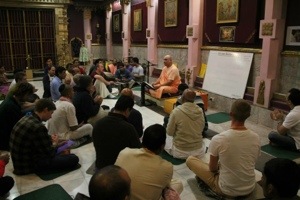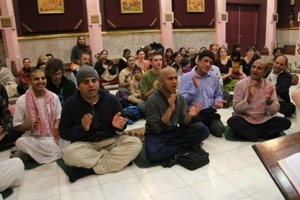Diary of a Traveling Sadhaka, Vol. 9, No. 9
By Krishna-kripa das
(May 2013, part one)
Holland, London, The North of England, Northern Ireland
(Sent from London, England, on June 13, 2013)
Where I Went and What I Did
After the Queen’s Day harinama, I stayed in Amsterdam and did harinama for three days. Then I went to Rotterdam for two days of harinama and a Saturday feast program. Next I went to Den Haag (The Hague) for an afternoon of harinama and a Sunday feast. Finally I returned to Amsterdam for harinama in Vondel Park. Then I did a day of harinama in London, harinama and a nama-hatta program in Sheffield, and went back to Newcastle, my summer base, where I stayed for four days of harinama and the Sunday feast lecture. Then I went on to Northern Ireland, where I chanted with Ananta Nitai Prabhu in Belfast for one day, and with both Ananta Nitai and Bhagavata Dasi in Lisburn, Bangor, Newry, and Hillsborough, all cities within an hour of Belfast, for the next four days. Thus it was a very busy time for me.
I share notes from Srila Prabhupada’s wonderful lectures and books. This month I had the opportunity to hear several classes by Kavicandra Swami, who remained in Amsterdam as long as his schedule would permit at the request of Kadamba Kanana Swami, who is always desirous of developing our outreach there. Kavicandra Swami is very perceptive and made lots of beautiful points in his classes which I share.
Thanksto Sanatani Devi Dasi for the photo of our Amsterdam harinama, onlooker John Doherty for the Hillsborough, Northern Island, picture of our harinamaparty, the web site http://www.discovernorthernireland.comfor the picture of the Hillsborough Tourism Centre, and an unknown passerby, who took our picture in Lisburn, chanting in front of the party shop.
Harinama in Amsterdam
I went on harinama for the entire week I spent in Holland, and only on the final day did I have go out alone. The weather was practically perfect the whole time. The first day we went out with Kavicandra Swami, who came out every day, and with some devotees from Scandinavia, who had come for the Queen’s Day harinama.
Another day on harinama two people joined our party at different times and chanted and danced with us. Tulasi Prabhu, a brahmacari book distributor from Bulgaria, later talked to one of these young men, who commented that he was curious what it was all about and purchased a Bhagavad-gita. Those are my favorite harinama experiences, when people become so interested they want to read the books.
The final day I spent in Amsterdam. I went out alone. I chanted as I walked through the streets for an hour and a half as went to and from Vondel Park, which Srila Prabhupada visited and in which gave a lecture many years ago. I chanted in the park itself for another three hours. One policeman called me over as soon as I got there, and I worried that I was not allowed to use my amplifier or I had done something else wrong, but he had no issues with me. While we talked, he mentioned he liked it on Queen’s Day when the group of us chanted together there by the museum where all the people were. I was pleased to hear a rare appreciation of the chanting from a cop.
Rotterdam and Den Haag
Sivananda Sena Prabhu and his wife, Moksa Lakshmi Devi Dasi, are disciples of Janananda Goswami, and like him, they have a fondness for promoting the congregational chanting of the holy name of the Lord in public. Thus they invited me for three harinamas and two programs in Rotterdam and Den Haag.
They regularly do two hours on chanting in Rotterdam on Fridays starting at the central train station at 7 p.m. They go to a crowded section with lots of shops.
Different onlookers were attracted and participated in dancing with the party.
I led half the kirtanaat the Saturday feast program in Rotterdamto let some of the others have some of the action.
In Den Haag there are two ISKCON temples. One I went to back in 2010, and the other I went this year. Before the Sunday program, we did harinama for over an hour in a local park, and several people happily danced.
The weather was excellent, and many people were happy to encounter the happily chanting devotees.
A Muslim family enjoyed dancing with us.
And other individuals did too.
London
In London one young French lady came to the temple one evening, and Erzsebet from Hungary, who is enthusiasm personified in outreach, sold her a book which she read that very night. She returned to the temple the next day and came to the lunch program lecture which I gave. Later I asked the devotee lady who talked to her during the lunch if the class had been beneficial for her. She said the French lady said she really liked the idea that we can have one of five relationships eternally with Krishna. The devotee lady asked her which one she liked, and she said she would like to be the friend or lover of Krishna eternally. I had spoken on the verse where Krishna states that he will reciprocate with us according to how we surrender to him. In his purport Srila Prabhupada writes, “One devotee may want Krishna as his supreme master, another as his personal friend, another as his son, and still another as his lover. Krishna rewards all the devotees, equally according to their different intensities of love for Him.” (Bg. 4.11, purport) I will keep this verse in mind as a good one to give introductory classes on that might attract one to Krishna. The French lady lives in Paris and shared contact information with devotee who spoke to her at lunch, so hopefully her interest will develop, and she will visit our temple there.
Sheffield
I chanted in Sheffield alone before the Wednesday nama-hatta meeting. Some people appreciated but one lady harassed me so much to give her a pound fifty for the bus, that I finally did so just to get her to go away.
It was nice to see a couple new people had become regulars at our Sheffield program since last year.
Leeds Farmers Market Harinama
My bus from Sheffield to Newcastle had a forty-minute rest in Leeds, and as we pulled into the coach station there, I noticed it was right next to the Leeds Farmers Market. When the bus stopped I learned of the break, and the bus driver advised me to go to the farmers market to get a bite to eat. I decided to go, not to shop, but to sing.
As soon as I sat down to saing, someone said, “Haribol!” And someone very soon gave a donation.
Newcastle Area Harinamas
I chanted in Newcastle, and different devotees would come out with me at different times. I would put out a hat to collect donations when we stayed in one place, and I would offer invitations and books to those who gave something, no matter how small. Because not everyone would take a book, I got enough in donations to pay for the books that were distributed. It was nice to always see books going out
The weather was wild. Some days were in the 40s F (5 to 10 C), and with winds from the north at 20 mph (32 kph).
In Sunderland we had four devotees, three singing and one distributing books. In addition, I was able to distribute three books myself by asking people who put money in the hat if they wanted one. We chanted about an hour and forty minutes. I like Sunderland because there are lots of people and always a few favorable ones. Kadamba Kanana Prabhu from Hungary had not been on harinama for ten years, and he was very happy he came out. One young lady who chanted with us got a call from a friend in London who asked if she was singing in Sunderland because someone had taken a video of her singing and put it on Facebook. Her friends from her hometown of Sunderland did not know much about her relationship with Hare Krishna, at least until now.
In Newcastle on Sunday, Bhakti Rasa and his wife, Kirtida Prabhu, came out, and we happened to meet Ekacakranatha Prabhu on the way.
We chanted three hours all together. People danced to the music, like these four guys below.
Harinamas in North Ireland
When my friend, Caitanya-candrodaya Prabhu, was temple president of Belfast, I got in the habit of going there and doing harinama. Devotees had occasionally talked about us chanting in different places around Belfast, but it did not happen until this year.
Monday Ananta Nitai Prabhu, who traveled by bus from Dublin, and I who traveled by plane from Newcastle, arrived at the Belfast temple within five minutes of each other. We were greeted by Bhagavata Dasi, our harinama partner from Govindadvipa, who moved back to Belfast and promised to take us out on harinama in her car the next four days. We were also greeted by all kinds of maha-prasadam, the opulence of a small temple. That day just Ananta Nitai and I went out to Belfast city center to chant for three hours. While traveling there by bus, the sun was shining, but as soon as I got off the bus, it started to rain. We found a sheltered spot to chant, and were greatly relieved when the sun shone again. But that was not for long. Soon it rained again. But again we were relieved when the sun again shone. During that harinama, the sun came out four times and it rained five times! As I walked back to take the bus home, chanting on the way, it was raining, but on the bus itself, the sun came out! That was the craziest weather I had experienced recently, but we were able to keep the chanting going the whole time, and collect donations and give out books and invitations as well.
On Tuesday, Bhagavata took us to Lisburn, about 15 minutes from the temple. We chanted on a main street and several groups of people stopped to watch at different times. At one point, we chanted under the sign of former birthday party shop underneath its sign “Pure Party.”
The congregational chanting is glorified by Lord Caitanya “cleansing the mirror of the mind,” and being “the nectar for which we are always anxious.” It is described by Narottama Das Thakura as imported from the spiritual world. For these reason, I thought “pure party” was a great description of harinama.
We found some teenage kids hanging out, and we sang in their midst for a while. I would have never done it myself, but the other devotees were better at dealing with kids than me, so I went along with it. At one point, the kids decided to harass us. Some of the more rowdy ones placed some nearby road construction barricades to surround our party, and they started throwing empty plastic bottles at us. We just kept chanting, and one of them decided to remove the barricades and throw the bottles in the trash so the other kids could not through them at us any more. Later someone asked us about our philosophy and one girl, who took pleasure in singing the whole mantra with us, gave us each some candy when she left. On the whole, the kids became more favorable as time marched on.
Since we had stopped chanting before we finished my quota of three hours, Ananta Nitai and I chanted in the parking lot of a store while Bhagavata did some shopping for the temple. We chanted for half an hour, and no authorities asked us to move, and some favorable people came by.
Wednesday we chanted in Bangor, and a passerby gave 10 British pounds for a Bhagavad-gita and a Sri Isopanisad. We chanted next to a butcher shop, and employees came out of the shop and looked at us from time to time but said nothing. After we chanted two and a half hours, a policeman came and explained that he had no problem with our singing, but some local vendors were complaining, and he told us of a couple other places where we could sing and would not get into difficulty. He was the most polite policeman who had ever asked us to move, and Ananta Nitai Prabhu gave him a small book which he accepted.
Thursday we chanted in Newry on a day where rain often threatened but was never so severe we had to stop. At several times groups of teenagers would sit behind us and move with the music.
On Friday we chanted in Hillsborough, a town of 3,400 people, where there was that day the Garden Show Ireland, an open house at the gardens of the Queen’s Hillsborough Castle.
John Doherty, an open-minded man, with both Catholic and Protestant connections, was attracted by our party and its chanting, appreciating its religious connection, and he took pictures of us, which he later send to me by email.
Often I give my business card to photographers who take pictures of us and ask them to send me the photos. They actually send me the photos 20% of the time at the very most, but in North Ireland and the Republic of Ireland people sent me the pictures two out of three or four times I asked for them.

A man behind the counter at tourist office, said to me, “Hare Krishna is from North India, isn’t it?"” I explained that the chanting we do in the streets, which we were doing outside his office for the last hour, started in Bengal. He inquired further, “And what is the name of the town in Bengal?” And I replied, “Mayapur.” And he said with a smile of recognition, “Oh yes, Mayapur!” Wow! I couldn’t believe it! In this tiny town in this remote land someone had heard of Mayapur, the birthplace of Sri Caitanya Mahaprabhu! Apparently the man spent some time in Kolkata and had eaten at our Govinda's Restaurant there. It is a small world!
The man also knew of Inis Rath island and their Sunday feast, and the lady in the office lived in Dunmurry, the Belfast suburb where our temple is, and she knew of our Sunday program there.
After Hillsborough, Ananta Nitai Prabhu and I boarded a bus for Dublin to continue our harinama adventures there
Insights
Srila Prabhupada:
from Srimad-Bhagavatam 4.28.31, purport:
“We have already started the International Society for Krishna Consciousness, and many thousands of Europeans and Americans have joined this movement. Indeed, it is spreading like wildfire. The cult of Krishna consciousness, based on the nine principles of devotional service (sravanam kirtanam visnohsmaranam pada-sevanam/ arcanam vandanam dasyam sakhyam atma-nivedanam[SB 7.5.23]), will never be stopped. It will go on without distinction of caste, creed, color or country. No one can check it.
from a lecture on Srimad-Bhagavatam5.5.2 given in London on September 17, 1969:
“The devotee aspires only to make friendship with Krishna. . . . The devotee’s only lovable object is Krishna.”
from a conversation in Durban, South Africa, in October 1975, printed in Back to Godhead, Volume 47, No. 4, p. 44:
Disciple: The scientists always say,“Last year we made a mistake, and now it’s all right.”
Srila Prabhupada: Hmm. “Now we are advanced.” And what is the guarantee that your present theories are correct? You will advance again. That means you are always incorrect.
Jiva Goswami:
from his Gopala Campu:
Krishna stole the gopi’scloth and their hearts and only returned their cloth. He did not return their hearts but hid them.
Srila Bhaktisiddhanta Sarasvati Thakura:
from his Amrita Vani, quoted in Back to Godhead, Volume 47, No. 4, p. 67:
We should show compassion toward all living entities, develop a taste for chanting the Lord’s names, and serve Vaishnavas. These are Mahaprabhu’s three principal
instructions.
Kavicandra Swami:
Another one of my godbrothers, Kesava Prabhu, left his body the other day. He is famous for book distribution. As president of the San Francisco temple, when he heard that Buddhimantra Prabhu had distributed twenty Krishna books one day, he sent Buddhimanta with a van loaded with Krishna books, saying, “Do not return until the van is empty.”
One dying devotee told some elementary school students, “I am dying” which was a shock to them. Then he continued, “but you might die before me” which shocked them even more [although it was certainly possible].
Ramachandra Khan wanted to defame Haridasa Thakura by sending a prostitute to break his vow of celibacy, but when Haridasa Thakura remained undisturbed and engaged the prostitute in pure devotional service to the Lord, he became more famous than before. Thus Ramachandra Khan was foiled in his attempt.
Ruci means having such a taste that you cannot stop chanting.
I watched many people from the crowd who were chanting at Queen’s Day.
In Tel Aviv many people dance with us.
In Puri Lord Caitanya sent people in groups of five to chant in front of people’s homes.
Although one newspaper article spoke critically of the devotees, Srila Prabhupada liked it because “Hare Krishna” was mentioned so many times. The offense is temporary, but the benefit of chanting the holy name is eternal.
The parents of one girl from Greece studied in London and heard the devotees chant on Oxford Street every day. Her father would sometimes bang on pots and jokingly say “Hare Krishna.” Later when she grew up, that girl was attracted to join the harinama in Greece and became a devotee.
Srila Prabhupada wanted many pictures to illustrate the Krishna book. He called them “windows to the spiritual world.” We would just show people the pictures in the books and tell the people, “these are windows to the spiritual world” and people would be amazed and buy the books.
Q: What gives us the taste for devotional service? What causes us to lose it?
A: Sadhu sanga sadhu sanga . . . By the mercy of the devotees one gets a taste for devotional service, and by offenses, especially offenses to devotees, one loses his taste.
The reasons a person falls down are the same, whether one is a sannyasi or an ordinary person.
When the Fifth Canto came out, many people left the movement. Some say it was because of the cosmology of the Bhagavatam, but I think it was the verses and purports that destroy the illusion of the pleasure of material sex life, which are great to read for one who actually wants to be renounced.
I think that the word “bloop” which in the Hare Krishna movement we use to mean to leave the spiritual path and return to materialistic life comes from the phrase “one falls down again into the material pool,” the word “bloop” being used in comics when an object falls into a pool of water. That phrase comes from a description of process of degradation in Bhagavad-gita 2.62–63: “While contemplating the objects of the senses, a person develops attachment for them, and from such attachment lust develops, and from lust anger arises. From anger, complete delusion arises, and from delusion bewilderment of memory. When memory is bewildered, intelligence is lost, and when intelligence is lost one falls down again into the material pool.”
People recognize that anger is bad and so they have classes to control anger, but unfortunately they do not have classes to control lust, which according to Bhagavad-gita 2.62,is the cause of anger.
In an art museum, when you see a beautiful piece of art, you glorify the artist, but when we see the beauty of nature, we do not glorify God, who is the artist. That is not right.
We are supposed to love people and use things, but in this degraded age, we love things and use people.
If you are facing the sun, you do not see the shadows, but if you face away from sun the shadows will be there. Similarly if one is facing Krishna, there will be no illusion for him.
Bhaktisiddhanta Sarasvati Thakura said some people say that Haridasa Thakura missed out on so many of the Lord Caitanya’s pastimes because he was always chanting, but because the holy name contains all the pastimes, that was not a fact.
In Japan when I would sell books, everyone said, “I am in a hurry. I have no time.” So I would say, “I am in a hurry too. Give me a donation quickly.” Many times people quickly gave me a donation.
If any other avatar of Krishna asked the demons for the nectar of immortality they would have fought Him for it, thus He appeared as a most attractive woman, and the lusty demons eagerly gave Her the nectar voluntarily desiring to please Her.
It appears that the devotees are also dying, but they do not have to accept another material body or suffer hellish punishment. They go to Krishna and live with Him forever.
The Hare Krishna mantra is the sword to cut the knot in the heart binding us to this body and this world.
Different people interact with the harinama party for different reasons, but they all are benefited.
When people get back from their vacations they have seen Hare Krishnas in London, they have seen Hare Krishnas in Amsterdam, and they have seen Hare Krishnas in Berlin.
Success means getting what you want. Happiness means wanting what you get.
If someone experiences a trauma they cannot get beyond, going to another place that does not remind them of the trauma helps.
Before Jahnava Mata, the eternal consort of Lord Nityananda Prabhu, would leave to travel to a new place, she would always ask the permission of the deity.
It is an important teaching of Lord Caitanya and all other spiritual teachers that one is judged by his qualities and activities, as Krishna mentions in Bhagavad-gita,and not by one’s birth. In Vrindavan, there are still brahmanas who will not eat with us Western mlecchasor eat grains cooked by us.
One of the first pollutions of the age of Kali is that the brahmanassay that one is a brahmana by birth and that a non-brahmana can never become a brahmana.
Sarvabhauma Bhattacharya tried to teach Mayavadi philosophy to Lord Caitanya, but Lord Caitanya ended up teaching Vaishnava philosophy to him.
The nondevotees cannot see Krishna so they take for granted that the devotees’ activities and their own activities are the same.
Both Bhakti Tirtha Swami and Devamrita Swami read Srila Prabhupada’s books and liked them, but when they first encountered the devotees, they thought the devotees were crazy.
Some say japa is just for ourselves, but a real Vaishnava does not think like that. He sees that his sadhana is meant for becoming empowered to help others.
Here in Amsterdam the people appreciate us. They do not know what we are doing, but they like it. Someday in the future, maybe a future lifetime, they will become devotees because of that appreciation.
Satyaraja Prabhu:
Many people don’t know this, but John Paul II confirmed that according to the teachings of Christianity that animals do indeed have souls. In 1990 he said that all creatures were given the “breath of life” by God, just like humans were. (See http://www.dreamshore.net/rococo/pope.html)
Urmila Devi:
from her article “The Swirling Smoke of Fragrant Love” in Back to Godhead, Volume 47, No. 4, p. 48:
“The most opulent arcana[worship of the Lord in his deity form] consists of sixty-four items; the most simple, five items.” In every list, offering incense to Krishna is included. Incense is part of worship of the Lord and His representatives in the scriptures of many of the world’s traditions. For example, when Jesus was born, the wise men brought the child gifts of frankincense and myrrh.
Ananta Nitai Prabhu:
Kirtana means glorification of the Supreme Lord, Vishnu, not any demigod.
Qualified personalities curse people for their benefit not for revenge.
On the harinama yesterday the kids did strange things like surround us with barricades and throw bottles at us, but one of the them, who was more pious, removed the barricades and put the bottles in the recycling bin so his friends could not keep throwing at us. Some of the kids ultimately chanted, gave us sweets, and inquired about what we were doing. So by association, they came up to a higher level of consciousness and activity.
On book distribution one lady claimed she had so many spirituals books she did not need a Bhagavad-gita, so I asked her if she would give me a banana in charity. As she went to get the banana, because she knew I was monk, she asked if I accepted donations, and I said, “Yes.” She returned with two bananas, two apples, and five-pound note. I presented her with a Bhagavad-gita, telling her to read at least the introduction and chapter two. And she smiled and said, “Thank you.”
from a conversation:
The worst anartha [undesirable quality] is to think you have no anarthas.
I have a couple devotee friends from England who were getting married about the same time and loved harinama. They both told their respective wives-to-be, “I like harinama so much that if you are not interested in it, you should go and marry someone else.” Both wives accepted the condition, and both couples have gone on harinama practically every weekend for the past eight years and are really empowered because of it.
Navina Syama Prabhu:
from his article, “Sherlock Holmes and the Limits of Modern Knowing” in Back to Godhead, Vol. 47, No. 4, (Jul/Aug 2013):
“For one exploring religion and seeking absolute knowledge, this uncertainty [of knowledge based on induction] is unacceptable. If it turns out that my theory about the
migration pattern of humpback whales is wrong, I might be a little embarrassed, but life will go on. If my understanding of God is off, on the other hand, the fate of my eternal soul hangs in the balance.” (p. 14)
“It is interesting to note that reliance on knowledge from authority is commonplace in modern society (e.g. students listening to teachers at school, viewers listening to news reporters on television), but that the approach is generally abandoned in spiritual matters.” (p. 15)
-----
etavan eva loke ’smin
pumam dharmah parah smritah
bhakti-yogo bhagavati
tan-nama-grahanadibhih
“Devotional service, beginning with the chanting of the holy name of the Lord, is the ultimate religious principle for the living entity in human society.” (Srimad-Bhagavatam 6.3.22)
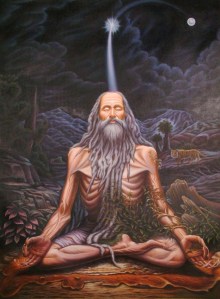 19-21
19-21
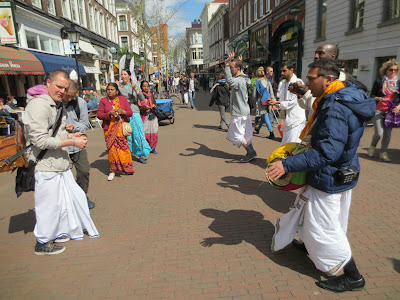
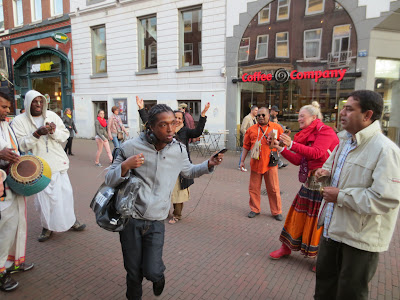


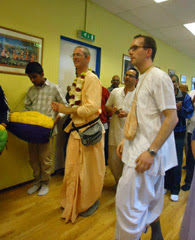
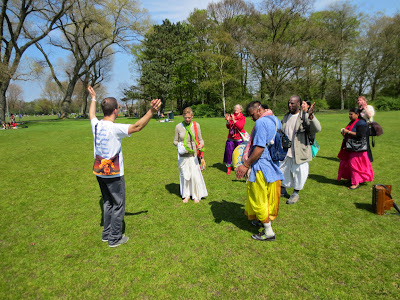


















 Dallas Morning News,
Dallas Morning News,

